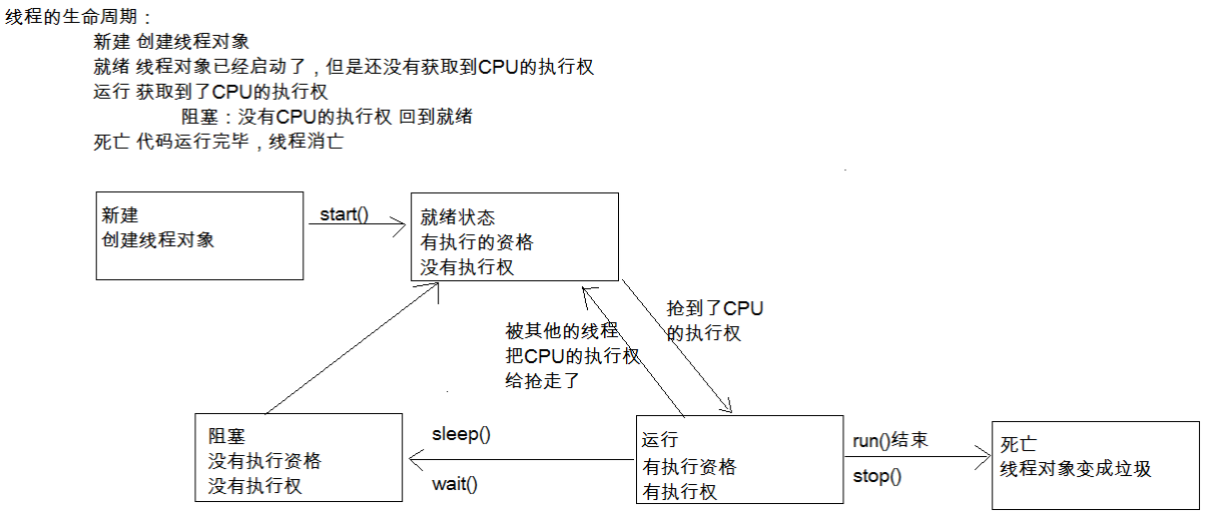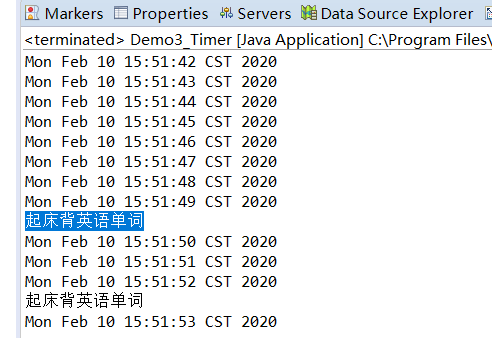线程状态图

-
单例设计模式:保证类在内存中只有一个对象。
-
如何保证类在内存中只有一个对象呢?
-
(1)控制类的创建,不让其他类来创建本类的对象。private
-
(2)在本类中定义一个本类的对象。Singleton s;
-
(3)提供公共的访问方式。 public static Singleton getInstance(){return s}
-
-
单例写法两种:
-
(1)饿汉式 开发用这种方式。
-
 View Code 单例模式-饿汉式
View Code 单例模式-饿汉式package com.heima.thread; public class test { /** * @param args * * 单例设计模式:保证类在内存中只有一个对象。 */ public static void main(String[] args) { Singleton s1 = Singleton.getInstance(); Singleton s2 = Singleton.getInstance(); System.out.println(s1 == s2); } } /** * 饿汉式 * */ class Singleton { //1,私有构造方法,其他类不能访问该构造方法了 private Singleton(){ } //2,创建本类对象 private static Singleton s = new Singleton(); //3,对外提供公共的访问方法 public static Singleton getInstance() { //获取实例 return s; } }
- (2)懒汉式 面试写这种方式。多线程的问题?
- //懒汉式,单例的延迟加载模式,有多线程访问的同步问题,实际工程一般不采用。
-
 View Code 单例模式-懒汉式
View Code 单例模式-懒汉式/* * 懒汉式,单例的延迟加载模式 */ class Singleton { //1,私有构造方法,其他类不能访问该构造方法了 private Singleton(){ } //2,声明一个引用 private static Singleton s ; //3,对外提供公共的访问方法 public static Singleton getInstance() { //获取实例 if(s == null) { //线程1等待,线程2等待 s = new Singleton(); } return s; } }
/*
* 饿汉式和懒汉式的区别
* 1,饿汉式是空间换时间,懒汉式是时间换空间
* 2,在多线程访问时,饿汉式不会创建多个对象,而懒汉式有可能会创建多个对象
*/
-
(3)第三种格式

class Singleton { //1,私有构造方法,其他类不能访问该构造方法了 private Singleton(){ } //2,声明一个引用 public static final Singleton s = new Singleton(); }
###25.03_多线程(Timer)(掌握)
- Timer类:计时器


package com.heima.thread; import java.util.Date; import java.util.Timer; import java.util.TimerTask; public class Demo3_Timer { /** * @param args * @throws InterruptedException */ public static void main(String[] args) throws InterruptedException { Timer t = new Timer(); //在指定时间安排指定任务 //第一个参数,是安排的任务,第二个参数是执行的时间,第三个参数是过多长时间再重复执行 t.schedule(new MyTimerTask(), new Date(120, 1, 10, 15, 51, 50),3000); while(true) { Thread.sleep(1000); System.out.println(new Date()); } } } class MyTimerTask extends TimerTask { @Override public void run() { System.out.println("起床背英语单词"); } }

-
1.什么时候需要通信
-
多个线程并发执行时, 在默认情况下CPU是随机切换线程的
-
如果我们希望他们有规律的执行, 就可以使用通信, 例如每个线程执行一次打印
-
-
2.怎么通信
-
如果希望线程等待, 就调用wait()
-
如果希望唤醒等待的线程, 就调用notify();
-
-
Demo1_Notify

package com.heima.thread2; public class Demo1_Notify { /** * @param args * 等待唤醒机制 */ public static void main(String[] args) { final Printer p = new Printer(); new Thread() { public void run() { while(true) { try { p.print1(); } catch (InterruptedException e) { e.printStackTrace(); } } } }.start(); new Thread() { public void run() { while(true) { try { p.print2(); } catch (InterruptedException e) { e.printStackTrace(); } } } }.start(); } } //等待唤醒机制 class Printer { private int flag = 1; public void print1() throws InterruptedException { synchronized(this) { if(flag != 1) { this.wait(); //当前线程等待 } System.out.print("黑"); System.out.print("马"); System.out.print("程"); System.out.print("序"); System.out.print("员"); System.out.print(" "); flag = 2; Thread.sleep(1000); //sleep不释放锁 this.notify(); //随机唤醒单个等待的线程 } } public void print2() throws InterruptedException { synchronized(this) { if(flag != 2) { this.wait(); } System.out.print("传"); System.out.print("智"); System.out.print("播"); System.out.print("客"); System.out.print(" "); flag = 1; Thread.sleep(1000); //sleep不释放锁 this.notify(); } } }
Demo2_NotifyAll

package com.heima.thread2; public class Demo2_NotifyAll { /** * @param args */ public static void main(String[] args) { final Printer2 p = new Printer2(); new Thread() { public void run() { while(true) { try { p.print1(); } catch (InterruptedException e) { e.printStackTrace(); } } } }.start(); new Thread() { public void run() { while(true) { try { p.print2(); } catch (InterruptedException e) { e.printStackTrace(); } } } }.start(); new Thread() { public void run() { while(true) { try { p.print3(); } catch (InterruptedException e) { e.printStackTrace(); } } } }.start(); } } /*1,在同步代码块中,用哪个对象锁,就用哪个对象调用wait方法 * 2,为什么wait方法和notify方法定义在Object这类中? * 因为锁对象可以是任意对象,Object是所有的类的基类,所以wait方法和notify方法需要定义在Object这个类中 * 3,sleep方法和wait方法的区别? * a,sleep方法必须传入参数,参数就是时间,时间到了自动醒来 * wait方法可以传入参数也可以不传入参数,传入参数就是在参数的时间结束后等待,不传入参数就是直接等待 * b,sleep方法在同步函数或同步代码块中,不释放锁,睡着了也抱着锁睡 * wait方法在同步函数或者同步代码块中,释放锁 */ class Printer2 { private int flag = 1; public void print1() throws InterruptedException { synchronized(this) { while(flag != 1) { this.wait(); //当前线程等待 } System.out.print("黑"); System.out.print("马"); System.out.print("程"); System.out.print("序"); System.out.print("员"); System.out.print(" "); flag = 2; //this.notify(); //随机唤醒单个等待的线程 this.notifyAll(); } } public void print2() throws InterruptedException { synchronized(this) { while(flag != 2) { this.wait(); //线程2在此等待 } System.out.print("传"); System.out.print("智"); System.out.print("播"); System.out.print("客"); System.out.print(" "); flag = 3; //this.notify(); this.notifyAll(); } } public void print3() throws InterruptedException { synchronized(this) { while(flag != 3) { this.wait(); //线程3在此等待,if语句是在哪里等待,就在哪里起来 //while循环是循环判断,每次都会判断标记 } System.out.print("i"); System.out.print("t"); System.out.print("h"); System.out.print("e"); System.out.print("i"); System.out.print("m"); System.out.print("a"); System.out.print(" "); flag = 1; //this.notify(); this.notifyAll(); } } }
###25.06_多线程(JDK1.5的新特性互斥锁)(掌握)
-
-
使用ReentrantLock类的lock()和unlock()方法进行同步
-
-
2.通信
-
使用ReentrantLock类的newCondition()方法可以获取Condition对象
-
需要等待的时候使用Condition的await()方法, 唤醒的时候用signal()方法
-
-
Demo3_ReentrantLock

package com.heima.thread2; import java.util.concurrent.locks.Condition; import java.util.concurrent.locks.ReentrantLock; public class Demo3_ReentrantLock { /** * @param args */ public static void main(String[] args) { final Printer3 p = new Printer3(); new Thread() { public void run() { while(true) { try { p.print1(); } catch (InterruptedException e) { e.printStackTrace(); } } } }.start(); new Thread() { public void run() { while(true) { try { p.print2(); } catch (InterruptedException e) { e.printStackTrace(); } } } }.start(); new Thread() { public void run() { while(true) { try { p.print3(); } catch (InterruptedException e) { e.printStackTrace(); } } } }.start(); } } class Printer3 { private ReentrantLock r = new ReentrantLock(); private Condition c1 = r.newCondition(); private Condition c2 = r.newCondition(); private Condition c3 = r.newCondition(); private int flag = 1; public void print1() throws InterruptedException { r.lock(); //获取锁 if(flag != 1) { c1.await(); } System.out.print("黑"); System.out.print("马"); System.out.print("程"); System.out.print("序"); System.out.print("员"); System.out.print(" "); flag = 2; //this.notify(); //随机唤醒单个等待的线程 c2.signal(); r.unlock(); //释放锁 } public void print2() throws InterruptedException { r.lock(); if(flag != 2) { c2.await(); } System.out.print("传"); System.out.print("智"); System.out.print("播"); System.out.print("客"); System.out.print(" "); flag = 3; //this.notify(); c3.signal(); r.unlock(); } public void print3() throws InterruptedException { r.lock(); if(flag != 3) { c3.await(); } System.out.print("i"); System.out.print("t"); System.out.print("h"); System.out.print("e"); System.out.print("i"); System.out.print("m"); System.out.print("a"); System.out.print(" "); flag = 1; c1.signal(); r.unlock(); } }

-
A:线程组概述
-
Java中使用ThreadGroup来表示线程组,它可以对一批线程进行分类管理,Java允许程序直接对线程组进行控制。
-
默认情况下,所有的线程都属于主线程组。
-
public final ThreadGroup getThreadGroup()//通过线程对象获取他所属于的组
-
public final String getName()//通过线程组对象获取他组的名字
-
-
-
1,ThreadGroup(String name) 创建线程组对象并给其赋值名字
-
2,创建线程对象
-
3,Thread(ThreadGroup?group, Runnable?target, String?name)
-
-
-

Demo4_ThreadGroup

package com.heima.thread2; public class Demo4_ThreadGroup { /** * @param args * ThreadGroup */ public static void main(String[] args) { //demo1(); ThreadGroup tg = new ThreadGroup("我是一个新的线程组"); //创建新的线程组 MyRunnable mr = new MyRunnable(); //创建Runnable的子类对象 Thread t1 = new Thread(tg, mr, "张三"); //将线程t1放在组中 Thread t2 = new Thread(tg, mr, "李四"); //将线程t2放在组中 System.out.println(t1.getThreadGroup().getName()); //获取组名 System.out.println(t2.getThreadGroup().getName()); tg.setDaemon(true); } public static void demo1() { MyRunnable mr = new MyRunnable(); Thread t1 = new Thread(mr, "张三"); Thread t2 = new Thread(mr, "李四"); ThreadGroup tg1 = t1.getThreadGroup(); ThreadGroup tg2 = t2.getThreadGroup(); System.out.println(tg1.getName()); //默认的是主线程 System.out.println(tg2.getName()); } } class MyRunnable implements Runnable { @Override public void run() { for(int i = 0; i < 1000; i++) { System.out.println(Thread.currentThread().getName() + "...." + i); } } }
###25.08_多线程(线程的五种状态)(掌握)
新建,就绪,运行,阻塞,死亡
public class Demo5_Executors { /** * public static ExecutorService newFixedThreadPool(int nThreads) * public static ExecutorService newSingleThreadExecutor() */ public static void main(String[] args) { ExecutorService pool = Executors.newFixedThreadPool(2);//创建线程池 pool.submit(new MyRunnable()); //将线程放进池子里并执行 pool.submit(new MyRunnable()); pool.shutdown(); //关闭线程池 } }
###25.09_多线程(线程池的概述和使用)(了解)
-
JDK5新增了一个Executors工厂类来产生线程池,有如下几个方法
-
public static ExecutorService newFixedThreadPool(int nThreads)
-
public static ExecutorService newSingleThreadExecutor()
-
这些方法的返回值是ExecutorService对象,该对象表示一个线程池,可以执行Runnable对象或者Callable对象代表的线程。它提供了如下方法
-
Future<?> submit(Runnable task)
-
<T> Future<T> submit(Callable<T> task)
-
-
-
-
好处:
-
可以有返回值
-
-
-

package com.heima.thread2; import java.util.concurrent.Callable; import java.util.concurrent.ExecutionException; import java.util.concurrent.ExecutorService; import java.util.concurrent.Executors; import java.util.concurrent.Future; public class Demo6_Callable { /** * @param args * @throws ExecutionException * @throws InterruptedException */ public static void main(String[] args) throws InterruptedException, ExecutionException { ExecutorService pool = Executors.newFixedThreadPool(2);//创建线程池 Future<Integer> f1 = pool.submit(new MyCallable(100)); //将线程放进池子里并执行 Future<Integer> f2 = pool.submit(new MyCallable(50)); System.out.println(f1.get()); System.out.println(f2.get()); pool.shutdown(); //关闭线程池 } } class MyCallable implements Callable<Integer> { private int num; public MyCallable(int num) { this.num = num; } @Override public Integer call() throws Exception { int sum = 0; for(int i = 1; i <= num; i++) { sum += i; } return sum; } }
-
A:简单工厂模式概述
-
又叫静态工厂方法模式,它定义一个具体的工厂类负责创建一些类的实例
-
-
B:优点
-
客户端不需要在负责对象的创建,从而明确了各个类的职责
-
-
C:缺点
-
这个静态工厂类负责所有对象的创建,如果有新的对象增加,或者某些对象的创建方式不同,就需要不断的修改工厂类,不利于后期的维护
-
Animal

package com.heima.简单工厂; public abstract class Animal { public abstract void eat(); }
Cat

package com.heima.简单工厂; public class Cat extends Animal { @Override public void eat() { System.out.println("猫吃鱼"); } }
Dog

package com.heima.简单工厂; public class Dog extends Animal { @Override public void eat() { System.out.println("狗吃肉"); } }
AnimalFactory

package com.heima.简单工厂; public class AnimalFactory { /*public static Dog createDog() { return new Dog(); } public static Cat createCat() { return new Cat(); }*/ //发现方法会定义很多,复用性太差 //改进 public static Animal createAnimal(String name) { if("dog".equals(name)) { return new Dog(); }else if("cat".equals(name)) { return new Cat(); }else { return null; } } }
Test

package com.heima.简单工厂; public class Test { /** * @param args */ public static void main(String[] args) { //Dog d = AnimalFactory.createDog(); Dog d = (Dog) AnimalFactory.createAnimal("dog"); d.eat(); Cat c = (Cat) AnimalFactory.createAnimal("cat"); c.eat(); } }
###25.12_设计模式(工厂方法模式的概述和使用)(了解)

Animal

package com.heima.工厂方法; public abstract class Animal { public abstract void eat(); }
Cat

package com.heima.工厂方法; public class Cat extends Animal { @Override public void eat() { System.out.println("猫吃鱼"); } }
Dog

package com.heima.工厂方法; public class Dog extends Animal { @Override public void eat() { System.out.println("狗吃肉"); } }
Factory接口

package com.heima.工厂方法; public interface Factory { public Animal createAnimal(); }
CatFactory

package com.heima.工厂方法; public class CatFactory implements Factory { @Override public Animal createAnimal() { return new Cat(); } }
DogFactory

package com.heima.工厂方法; public class DogFactory implements Factory { @Override public Animal createAnimal() { return new Dog(); } }
Test

package com.heima.工厂方法; public class Test { /** * @param args */ public static void main(String[] args) { DogFactory df = new DogFactory(); Dog d = (Dog) df.createAnimal(); d.eat(); } }
###25.19_设计模式(适配器设计模式)(掌握)
-
a.什么是适配器
-
在使用监听器的时候, 需要定义一个类事件监听器接口.
-
通常接口中有多个方法, 而程序中不一定所有的都用到, 但又必须重写, 这很繁琐.
-
适配器简化了这些操作, 我们定义监听器时只要继承适配器, 然后重写需要的方法即可.
-
-
b.适配器原理
-
适配器就是一个类, 实现了监听器接口, 所有抽象方法都重写了, 但是方法全是空的
-
适配器类需要定义成抽象的,因为创建该类对象,调用空方法是没有意义的
-
目的就是为了简化程序员的操作, 定义监听器时继承适配器, 只重写需要的方法就可以了
-

package com.heima.适配器; public class Demo1_Adapter { /** * @param args * 适配器设计模式 * 鲁智深 */ public static void main(String[] args) { } } interface 和尚 { public void 打坐(); public void 念经(); public void 撞钟(); public void 习武(); } //声明成抽象的原因是,不想让其他类创建本类对象,因为创建也没有意义,方法都是空的 abstract class 天罡星 implements 和尚 { @Override public void 打坐() { } @Override public void 念经() { } @Override public void 撞钟() { } @Override public void 习武() { } } class 鲁智深 extends 天罡星 { public void 习武() { System.out.println("倒拔垂杨柳"); System.out.println("拳打镇关西"); System.out.println("大闹野猪林"); System.out.println("......"); } }
###25.20_GUI(需要知道的)
-
事件处理
-
事件: 用户的一个操作
-
事件源: 被操作的组件
-
监听器: 一个自定义类的对象, 实现了监听器接口, 包含事件处理方法,把监听器添加在事件源上, 当事件发生的时候虚拟机就会自动调用监听器中的事件处理方法。
-
用自己的语言描述下列问题,要尽量详细,不要过于依赖笔记,自己能想到的也算(实在不会整理背标准答案,明天课前提问)
1、单例设计模式,适配器设计模式
2、饿汉式和懒汉式的区别
4、Timer类是干嘛的
5、wait和sleep的区别
6、线程的生命周期(五中状态的切换流程)

用自己的语言描述下列问题,要尽量详细,不要过于依赖笔记,自己能想到的也算 1、单例设计模式,适配器设计模式 单利设计模式: 在java中,单例模式是指为了保证类在内存中只有一个对象,而形成的一种固有的代码模式! 适配器设计模式: 在java中,适配器设计模式是指为了监视某些行为,但是对于每种监听到的行为又有不同的处理,为了能够让监听者自行来处理监听到指定行为后,要做的后续操作,而形成的一种固有的代码模式! 适配器标准课上答案: * a.什么是适配器 * 在使用监听器的时候, 需要定义一个类事件监听器接口. * 通常接口中有多个方法, 而程序中不一定所有的都用到, 但又必须重写, 这很繁琐. * 适配器简化了这些操作, 我们定义监听器时只要继承适配器, 然后重写需要的方法即可. * b.适配器原理 * 适配器就是一个类, 实现了监听器接口, 所有抽象方法都重写了, 但是方法全是空的. * 适配器类需要定义成抽象的,因为创建该类对象,调用空方法是没有意义的 * 目的就是为了简化程序员的操作, 定义监听器时继承适配器, 只重写需要的方法就可以了. 2、饿汉式和懒汉式的区别 使用场合: 饿汉式: 开发用 懒汉式: 面使用,开发一般不用 思想: 饿汉式: 类一加载就生成对象。 懒汉式: 在调用获取对象的方法的时候生成。 实用性: 饿汉式: 安全,效率高。相对懒汉式会在未使用之前就占用内存。 懒汉式: 存在线程安全漏洞,可以利用同步解决,但是效率会变低。内存方面符合了编程中的延迟加载思想。(在面试中面试官会比较希望答出这一点) 3、Timer类是干嘛的 Timer类是计时器。 一般的使用过程是在Timer类的schedule()方法中传入两个参数,一个TimerTask的子类对象,在这个子类对象中规定了计时结束的操作,另一个java.util.Date类的对象,其参数指定了计时的开始时间和循环周期, 4、wait和sleep的区别 sleep方法:定义在Thread类中,让线程在指定时间内处于休眠状态,超时后继续向下执行,休眠的线程不会释放锁资源。 wait方法 :定义在Object类中,让以当前对象为监视器的线程处于阻塞状态,不可获取执行权,在得到notify或者notifyAll的通知后再继续抢夺执行权。等待的线程会释放锁资源。 5、线程的生命周期(五中状态的切换流程) 线程分为5个生命周期,新建,就绪,运行,阻塞,死亡 其中: 新建代表线程在内存中创建,对应start方法。 就绪代表线程拥有抢夺执行权的资格,如果抢到就会执行线程中的内容 运行代码线程中的内容正在执行。 a:若被抢走执行权,回到就绪状态 b:若执行ssleep、wait等方法,会进入阻塞状态。 阻塞代表线程被强制不可进入就绪状态,对于非就绪状态的线程是没有机会抢夺执行权,也就更不可能进入运行状态了。 死亡代表线程运行结束,也可能是被强制结束,一般不建议使用。
